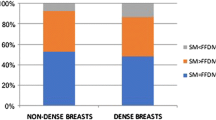Abstract
Aims and objectives
The aim of this study was to determine if the synthetic C view acquired at digital breast tomosynthesis (DBT) would give adequate information to confirm a malignancy and could obviate the need to review all the tomosynthesis image data set.
Methods
All patients with biopsy-proven breast cancer recalled from screening mammograms between May and September 2016 were included for review. For each patient, the screening 2D mammogram, the synthetic C view, and the DBT images were reviewed by three breast radiologists and each assigned a BIRADS code. Any discrepancies were reviewed and resolved by consensus.
Results
A total of 92 patients were diagnosed with breast cancer in this time period. Fourteen were excluded because they did not have DBT performed. Five women were recalled for evaluation of two lesions. In total, 83 lesions were assessed. In 27 cases, the BIRADS code remained unchanged in the three modalities. In 16 cases, the lesions appeared more concerning on C view and DBT that on the original mammogram but were not definitive for malignancy (BIRADS 4). In 29 cases, a BIRADS 5 code was assigned on C view and tomosynthesis but not on 2D. For 11 lesions, a BIRADS 5 code was assigned only on DBT. Four women had BIRADS 5 lesions seen on both the C view and DBT that were not seen on the screening 2D mammogram. One was multifocal.
Conclusion
While the synthetic C view gives additional information when compared to a screening 2D mammogram, the full DBT tomosynthesis data set needs to be reviewed to diagnose a breast malignancy.



Similar content being viewed by others
References
The benefits and harms of breast cancer screening: an independent review. Independent UK Panel on Breast Cancer Screening. Lancet, 2012. 380(9855):1778–86. doi: https://doi.org/10.1016/S0140-6736(12)61611-0
Tabár L, Vitak B et al (2011) Swedish two-county trial: impact of mammographic screening on breast cancer mortality during 3 decades. Radiology 260(3):658–663. https://doi.org/10.1148/radiol.11110469
Carney PA, Miglioretti DL (2003) Individual and combined effects of age, breast density, and hormone replacement therapy use on the accuracy of screening mammography. Ann Int Med 138(3):168–175
Breast screening review—a radiologist’s perspective. M.J. Michell. Br J Radiol, 2012. pp. 845–847
Gilbert FJ, Tucker L, Young KC (2016) Digital breast tomosynthesis (DBT): a review of the evidence for use as a screening tool. Clin J Radiol 71(2):141–150. https://doi.org/10.1016/j.crad.2015.11.008
Skaane P, Bandos AI et al (2013) Comparison of digital mammography alone and digital mammography plus tomosynthesis in a population-based screening program. Radiology 267(1):47–56. https://doi.org/10.1148/radiol.12121373
Svahn H, Sechopoulos M (2015) Review of radiation dose estimates in digital breast tomosynthesis relative to those in two-view full-field digital mammography. Breast 24(2):93–99. https://doi.org/10.1016/j.breast.2014.12.002
Nelson JS, Wells JR et al (2016) How does c-view image quality compare with conventional 2D FFDM? Med Phys 43(5):2538–2547. https://doi.org/10.1118/1.4947293
Zuley M, Guo B et al (2014) Comparison of two-dimensional synthesized mammograms versus original digital mammograms alone and in combination with tomosynthesis images. Radiology 271(3):664–671
Kuhl C, Schrading S et al (2013) Accelerated breast MRI for breast cancer screening. J Clin Oncol 31(26_suppl):1. https://doi.org/10.1200/jco.2013.31.26_suppl.1
Author information
Authors and Affiliations
Corresponding author
Rights and permissions
About this article
Cite this article
Murphy, M.C., Coffey, L., O’Neill, A.C. et al. Can the synthetic C view images be used in isolation for diagnosing breast malignancy without reviewing the entire digital breast tomosynthesis data set?. Ir J Med Sci 187, 1077–1081 (2018). https://doi.org/10.1007/s11845-018-1748-7
Received:
Accepted:
Published:
Issue Date:
DOI: https://doi.org/10.1007/s11845-018-1748-7




